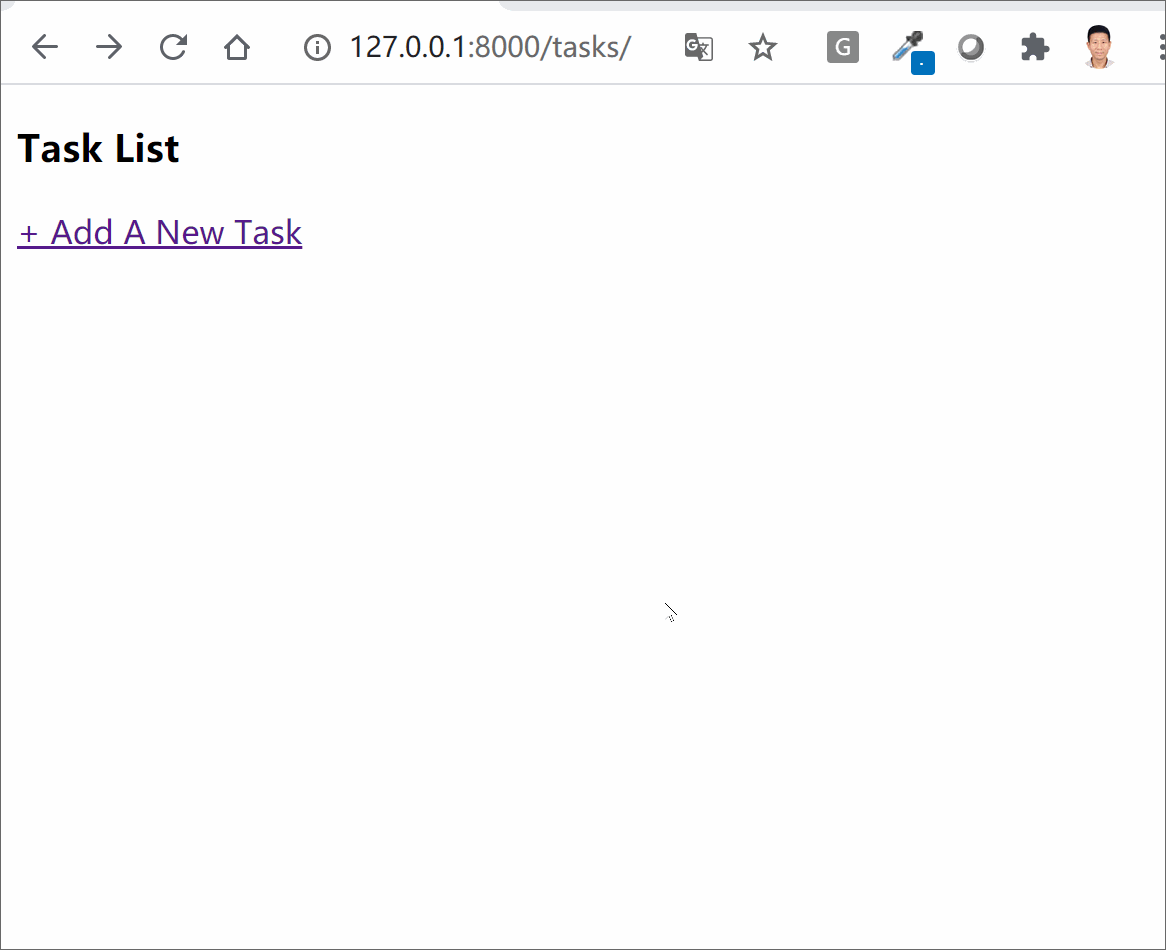A Simple Example of Django CRUD (Create, Retrieve, Update and Delete) Application Using Functional Based Views
We will use Django and functional based views to develop a simple application to allow one to create a new task, retrieve task list or a single task, update a task and delete a task.
If you cannot see the animated gif below, please download task_crud.gif and open it in our browser.
First of all, use python manage.py startapp tasks to create a new app named "tasks" and then add it to INSTALLED_APPS in settings.py.
INSTALLED_APPS = [
'django.contrib.admin',
'django.contrib.auth',
'django.contrib.contenttypes',
'django.contrib.sessions',
'django.contrib.messages',
'django.contrib.staticfiles',
'tasks',
]Then add app urls to project urls.
from django.contrib import admin
from django.urls import path, include
urlpatterns = [
path('admin/', admin.site.urls),
path('tasks/', include('tasks.urls'))
]Our Task model is very simple. We also used ModelForm to create a TaskForm which will then be needed to create or update a task.
# tasks/models.py
from django.db import models
class Status(models.TextChoices):
UNSTARTED = 'u', "Not started yet"
ONGOING = 'o', "Ongoing"
FINISHED = 'f', "Finished"
class Task(models.Model):
name = models.CharField(verbose_name="Task name", max_length=65, unique=True)
status = models.CharField(verbose_name="Task status", max_length=1, choices=Status.choices)
def __str__(self):
return self.name
# tasks/forms.py
from .models import Task
from django import forms
class TaskForm(forms.ModelForm):
class Meta:
model = Task
fields = "__all__"We will create 5 urls and 5 associated functional based views to deal with the CRUD activities. Please bear in mind that we need 2 views for the Retrieve activities: one for retrieving a list and the other for retrieving a single object.
# tasks/urls.py
from django.urls import path, re_path
from . import views
# namespace
app_name = 'tasks'
urlpatterns = [
# Create a task
path('create/', views.task_create, name='task_create'),
# Retrieve task list
path('', views.task_list, name='task_list'),
# Retrieve single task object
re_path(r'^(?P<pk>\d+)/$', views.task_detail, name='task_detail'),
# Update a task
re_path(r'^(?P<pk>\d+)/update/$', views.task_update, name='task_update'),
# Delete a task
re_path(r'^(?P<pk>\d+)/delete/$', views.task_delete, name='task_delete'),
]The code below in the core of this example. Please try to understand every line in it.
# tasks/views.py
from django.shortcuts import render, redirect, get_object_or_404
from django.urls import reverse
from .models import Task
from .forms import TaskForm
# Create your views here.
# Create a task
def task_create(request):
if request.method == "POST":
form = TaskForm(request.POST)
if form.is_valid():
form.save()
return redirect(reverse("tasks:task_list"))
else:
form = TaskForm()
return render(request, "tasks/task_form.html", { "form": form, })
# Retrieve task list
def task_list(request):
tasks = Task.objects.all()
return render(request, "tasks/task_list.html", { "tasks": tasks,})
# Retrieve a single task
def task_detail(request, pk):
task = get_object_or_404(Task, pk=pk)
return render(request, "tasks/task_detail.html", { "task": task, })
# Update a single task
def task_update(request, pk):
task_obj = get_object_or_404(Task, pk=pk)
if request.method == 'POST':
form = TaskForm(instance=task_obj, data=request.POST)
if form.is_valid():
form.save()
return redirect(reverse("tasks:task_detail", args=[pk,]))
else:
form = TaskForm(instance=task_obj)
return render(request, "tasks/task_form.html", { "form": form, "object": task_obj})
# Delete a single task
def task_delete(request, pk):
task_obj = get_object_or_404(Task, pk=pk)
task_obj.delete()
return redirect(reverse("tasks:task_list"))We only need to create 3 templates: task_list.html, task_detail.html and task_form.html. The last template will be shared by task_create and task_update views.
# tasks/templates/tasks/task_list.html
<!DOCTYPE html>
<html lang="en">
<head>
<meta charset="UTF-8">
<title>Task List</title>
</head>
<body>
<h3>Task List</h3>
{% for task in tasks %}
<p>{{ forloop.counter }}. {{ task.name }} - {{ task.get_status_display }}
(<a href="{% url 'tasks:task_update' task.id %}">Update</a> |
<a href="{% url 'tasks:task_delete' task.id %}">Delete</a>)
</p>
{% endfor %}
<p> <a href="{% url 'tasks:task_create' %}"> + Add A New Task</a></p>
</body>
</html>
# tasks/templates/tasks/task_detail.html
<!DOCTYPE html>
<html lang="en">
<head>
<meta charset="UTF-8">
<title>Task Detail</title>
</head>
<body>
<p> Task Name: {{ task.name }} | <a href="{% url 'tasks:task_update' task.id %}">Update</a> |
<a href="{% url 'tasks:task_delete' task.id %}">Delete</a>
</p>
<p> Task Status: {{ task.get_status_display }} </p>
<p> <a href="{% url 'tasks:task_list' %}">View All Tasks</a> |
<a href="{% url 'tasks:task_create'%}">New Task</a>
</p>
</body>
</html>
# tasks/templates/tasks/task_form.html
<!DOCTYPE html>
<html lang="en">
<head>
<meta charset="UTF-8">
<title>{% if object %}Edit Task {% else %} Create New Task {% endif %}</title>
</head>
<body>
<h3>{% if object %}Edit Task {% else %} Create New Task {% endif %}</h3>
<form action="" method="post" enctype="multipart/form-data">
{% csrf_token %}
{{ form.as_p }}
<p><input type="submit" class="btn btn-success" value="Submit"></p>
</form>
</body>
</html>
python manage.py makemigrations
python manage.py migrate
python manage.py runserver
